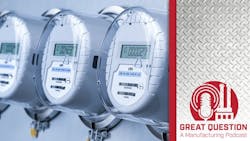Podcast: Smart metering for manufacturers – Should you make the switch?
Satish Saini has over 30 years of experience in the power systems industry and is currently a utilities industry specialist at HEXstream. Among his achievements, Satish is a member of the Advisory Council of Engineers on Energy Transition to the United Nations Secretary General and leads the U.N. working group on energy efficiency and management, transmission and distribution, utilities and energy consumers. Additionally, Satish serves as chairman of the IEEE Smart Grid Technical Activities Committee. Satish recently spoke with Smart Industry managing editor Scott Achelpohl about how smart or advanced metering can help manufacturers cut energy costs, enhance reliability and bolster conservation and sustainability.
Below is an excerpt from the podcast:
SI: Satish, what is advanced metering or smart metering? Can you tell the podcast listeners about the technology involved and how much interaction is required with their local utility? Can you tell us more about these technologies and how they function?
SS: Advanced metering infrastructure, which we also call AMI or smart metering infrastructure, is a comprehensive system that is comprised of mainly three things like smart meters, which are electronic meters that are installed at consumer premises. The second component is the communication network, which communicates between the smart meters at the consumer premises and the central system or the local utility premises or the vendor system. So, it's a two-way communication between the utility and the consumer related to the meter, data energy consumption, and other parameters of the power system. So, the second component is communication, and the third component is MDMS which is meter data management system, which is the software and platform that manages and processes all this energy consumption and other data which it receives from the energy meters and conveys through the communication network. AMI basically is real-time information, as well as periodic information, which is based on 15-minute, 30-minute or 60-minutes intervals that we program. This is data monitoring, management, and analysis of energy usage and the cost. So, this real-time or interval data enhances the efficiency and the viability of our electrical power distribution system and gives more power and tools to the customer to manage their usage and the energy costs.
SI: Satish, what other information does advanced metering infrastructure gather?
SS: Other than customer energy usage and the relevant cost of energy, AMI also monitors and manages data which is related to the key parameters of the power system, like power quality, voltage level, spikes and dips in the voltage and the current, and the power factor for the industry, and many more as well. So these are the key parameters to supply quality and reliable power to the customers, which can be residential, industrial or commercial.
SI: Other than these metering parameters, like energy usage, cost, etc., what else does the utility and the customer gain from this infrastructure?
SS: It's a good question because there's a lot. With the development of metering products, technology and innovation, and advanced data analytics, both the utilities and their end customers, they gain numerous benefits from this infrastructure. For example, with all the AMI data which we receive from the customer premises, the utility can manage the grid assets like the transformers, their feeders, or their substations, and they can also effectively manage the outages in the system in the areas that affect various customers. And they can proactively communicate with their customers regarding outages, and customers can also gain more information and more engagement. So the other great benefit for the customers is managing demand and load at peak times to avoid blackouts or brownouts, and also various energy efficiency programs, which we can do effectively through this infrastructure between the utility and the customer.
About the Podcast
Great Question: A Manufacturing Podcast offers news and information for the people who make, store and move things and those who manage and maintain the facilities where that work gets done. Manufacturers from chemical producers to automakers to machine shops can listen for critical insights into the technologies, economic conditions and best practices that can influence how to best run facilities to reach operational excellence.
Listen to another episode and subscribe on your favorite podcast app
About the Author
Scott Achelpohl
Scott Achelpohl is the managing editor of Smart Industry. He has spent stints in business-to-business journalism covering U.S. trucking and transportation for FleetOwner, a sister website and magazine of SI’s at Endeavor Business Media, and branches of the U.S. military for Navy League of the United States. He's a graduate of the University of Kansas and the William Allen White School of Journalism with many years of media experience inside and outside B2B journalism.
